Eight years after Nissan lifted the covers on what would become the world’s first mass-market battery-electric vehicle, the Japanese automaker has just launched production of the all-new, second-generation Nissan Leaf.
Plenty has changed since the original model came to market. Batteries are growing more powerful, even as their price has fallen more than six-fold since the beginning of the decade, translating into longer range at lower costs. And while “BEVs” still make up little more than a rounding error when it comes to overall U.S. sales, demand is clearly growing. But so is the list of competitors Leaf has to stare down, including both the Chevrolet Bolt EV and the Tesla Model 3.
With the Gen-2 Leaf, Nissan chose to walk a tightrope. It doesn’t offer quite as much range as the Chevy and Tesla battery-cars, but it’s thousands of dollars cheaper. The 2018 Leaf is also less wonky in appearance and a lot more fun to drive than the model it replaced, TheDetroitBureau.com discovered, during a long day of driving through fire-scarred Napa Valley earlier this month.
The original Leaf seemed quite proud of its geeky shape, with details like bulging head and taillights said to help improve aerodynamic performance – which translated into better range. It was obvious that Nissan’s design team had embraced the Toyota Prius strategy: when it comes to alternative power, the weirder the styling the better.
The new Leaf is a fair bit more conventional, with a more coupe-like roofline flowing into its hatchback rear. It adopts familiar Nissan design cues, starting with the brand’s V-Motion grille, “boomerang” front and rear lamps and blacked-out pillars that make the roof appear to float. But there are some distinctive touches to remind you this isn’t just another five-door, including the layered blue accents on the grille.
(Nissan may amp up its new Leaf EV with NISMO Touch. Click Here for the story.)
The 2018 Leaf development team didn’t start from scratch. The underlying platform is largely carryover, though there was a concerted effort to fix niggling annoyances – such as the intrusions that limited cargo and passenger space – and improve things like noise, vibration and harshness, or NVH in engineer-speak. Dimensionally, the new Leaf grows a modest 1.4 inches in length, 0.8 inches in width and 0.4 inches in height.
It also adds about 242 pounds of mass. “What?” you might be wondering about now. Isn’t mass the enemy of electric vehicles and the reason why BMW opted for costly carbon fiber, rather than steel or even aluminum, for the little i3 city car? Well, yes, but there’s a heck of a lot more content on the new Nissan Leaf, starting with a 50% increase in its lithium-ion battery pack which jumps to 40 kilowatt-hours.
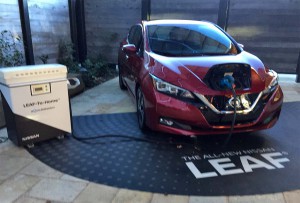
Nissan is preparing its Leaf-to-Home charger for the U.S. The system allows the Leaf to provide power to a home in emergency situations.
That, in turn, yields a substantial, 40% more range, at 150 miles per charge, than the outgoing, 2017 model – and nearly twice as much as the original version of the Leaf could muster.
That’s a major improvement that translates into what Nissan Leaf project manager Scott Thunes called “improved range confidence,” though definitely not up to the 238 miles the Bolt can manage. But the development and marketing teams came to the conclusion that there’s a sweet spot in the market for an electric that can comfortably handle day-to-day chores with plenty of energy left over for emergencies – like racing home from work to take care of a sick child.
“Leaf is a value proposition,” explained Thunes, in a background briefing before we headed out for our day’s drive. Even before factoring in the federal $7,500 tax credit the 2018 model starts at just $29,990, or about what a Bolt costs – with the credit. That’s also about $1,000 less than the shorter-range 2017 Leaf.
The good news is that for those who would really like a Leaf but want a bit more range, Thunes confirmed a battery upgrade will be introduced later next year and “it will be over 200 miles.” That will likely mean 60 kilowatt-hours or slightly higher.
Even with the current, 40 kWh battery, we found ourselves seldom bothering to look at the energy gauge. And that’s despite the fact that we didn’t baby the 2018 Leaf the way we did the original, when we were prone to breaking a sweat over every high-speed pass, wondering how much of our precious power was being consumed.
Better yet, those passes were made a lot more quickly with the new model. The Leaf’s single electric motor now produces 147 horsepower and 236 pound-feet of torque, up from 107 and 187, respectively. The original battery-car was acceptably peppy for city driving, pretty much settling back into the stone pony class at speeds above 30 mph. The new one hits 60 in about eight seconds, or a full two seconds faster than before.
No, that’s not Tesla’s Ludicrous Mode, but at the Tokyo Motor Show back in October Nissan did hint that it just might be working up a high-performance NISMO version that could take much better advantage of the instant torque electric motors can develop when you have the power to feed them.
Beyond the improvements in acceleration, the 2018 Nissan Leaf’s steering has been firmed up just enough to give you a good feel of the road and more confidence going into the sort of sharp corners we traversed up in Napa.
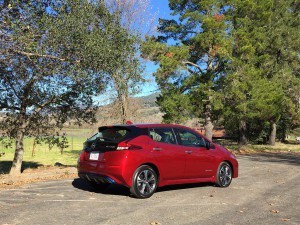
The 2018 Leaf's exterior adopts more of Nissan's traditional design cues, moving away from the quirkier design of the first model.
Back at the ranch, at the end of the day, Nissan’s events team plugged our Leaf back in for an overnight charge to have it ready for the next wave of journalists. As before, you can plug into a standard 120-volt outlet, at least if you’re not planning to go back out for the better part of the day. Switching to its 6.6 kW charger cuts your time to a short night.
(Click Here for details about Nissan’s plan to launch autonomous robocabs.)
There’s an optional 50 kW CHAdeMO port that allows a driver to access the new Level 3 charging stations popping up across the country. They’ll give the Leaf 80% of its battery capacity in just 30 minutes. There’s also an optional, portable charger that can plug into standard 120- or 240-volt outlets. It means owners don’t need to hardwire in a Level 2 charger, just the correct plug. While no word from Nissan, we also expect to see the maker introduce its first induction charging system – the automotive equivalent of a Qi smartphone charger – during the latest Leaf’s lifecycle.
Nissan is also working up a system it calls Leaf-to-Home that will allow a motorist to not only charge through their home’s power supply but, if needed, turn the Leaf’s battery pack into a back-up power supply. That concept is already being used by thousands of EV owners in Japan though Scott Brierley, who heads the project for the U.S. market, said “We don’t have a firm date when it will come out” here.
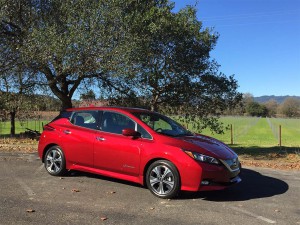
The 2018 Nissan Leaf travels 150 miles on a single charge while sprinting from 0-to-60 mph in 8 seconds.
Nissan isn’t viewing the Leaf as just another basic form of transportation. It is looking at all sorts of high-tech opportunities. And that includes ways to integrate that into other elements of your life. A critical tool is the upgraded smartphone app available for the 2018 model. It adds a number of functions and upgrades others, such as allowing you to set a specific temperature for the cabin when you turn on the pre-heat function (which is best done while hooked up to a charger).
Functions like “My Car Finder” also can be operated through an Apple watch which now even displays a map. And you can control your car with an Amazon Echo, as well as your smartphone. For the moment, Nissan hasn’t added the ability to operate home automation devices, such as lights or a garage door, from inside the car, but stay tuned, we were told. And the new Leaf has added smartphone-like over-the-air upgrade capabilities, so many of those features, if they’re software-based, can be reprogrammed into the car remotely.
Two other new features of note include:
- The new e-Pedal, which lets you drive with one foot under most circumstances. When you lift the throttle the car uses the regenerative braking system to slow down more rapidly than you’d experienced with a gas-powered vehicle. It will bring you to a complete stop, in fact. It does take a bit of getting used to to understand how much to lift up on the throttle but once you’re comfortable with the feature you seldom wind up using the brakes;
- ProPilot Assist is Nissan’s first foray into semi-autonomous driving. It uses radar and a mirror-mounted camera to keep you centered in your lane while also adjusting the vehicle’s speed to suit traffic. You still need to keep your hands on the wheel, albeit lightly. There need to be lane markers and the system can’t handle sharp corners. It’s a nice first step but not quite up to Tesla’s Autopilot or Cadillac’s Super Cruise.
The 2018 Nissan Leaf also adds a variety of advanced driver assistance systems, some as standard gear, some optional. That includes forward collision warning with auto-braking, lane departure warning and blind-spot monitoring.
On the whole, we found few things to really complain about with the 2018 Nissan Leaf – the quirky electronic shifter design being one of our few quibbles. The Gen-2 model is a major improvement over the original battery-electric vehicle. Some folks will love the new design, others might still find it geeky. But it’s hard to complain about the improved range – especially when you factor in the under-$30,000 starting price – as well as the increased performance.
(To see more about Nissan’s future electrification plans, Click Here.)
Battery-cars still aren’t for everyone, but we think Nissan has come up with a package that will markedly expand the potential market.

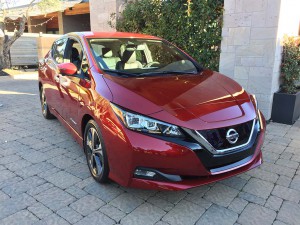
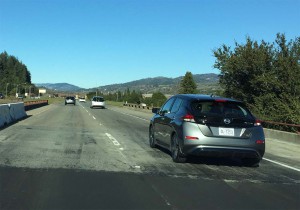
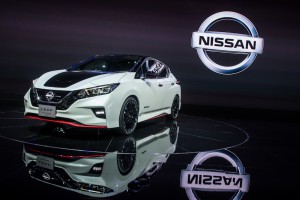
looks like it’s gonna blast the auto industry because it is better than the other cars in every aspects